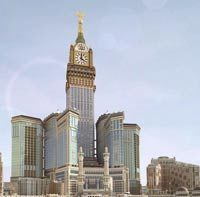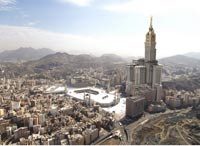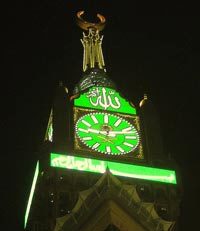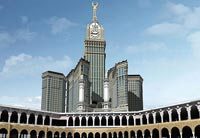
|
The Abraj Al-Bait Towers, also known as the Mecca Royal Hotel Clock Tower, is a building complex in Mecca, Saudi Arabia, the complex holds several world records, such as the tallest hotel in the world, the tallest clock tower in the world, the world’s largest clock face, and the world’s largest building floor area. The complex’s hotel tower became the second tallest building in the world in 2011, surpassed only by Dubai’s Burj Khalifa. The building complex is meters away from the world’s largest mosque and Islam’s most sacred site, the Masjid al Haram. The developer and contractor of the complex is the Saudi Binladin Group, the Kingdom’s largest construction company.The tallest tower in the complex stands as the tallest building in Saudi Arabia, and the tallest and largest hotel in the world, with a height of 601 metres (1,972 feet). It is the fourth tallest building under construction. Upon its official opening the structure would surpass Dubai International Airport having the largest floor area of any structure in the world with 1,500,000 m2 (16,150,000 sq ft) of floorspace. It also surpassed the Emirates Park Towers in Dubai as the world’s tallest hotel.The site of the complex is located across the street to the south from an entrance to the Masjid al Haram mosque, which houses the Kaaba. To accommodate worshipers visiting the Kaaba, the Abraj Al-Bait Towers has a large prayer room capable of holding more than 10,000 people. The tallest tower in the complex also contains a five-star hotel to help provide lodging for the millions of pilgrims that travel to Mecca annually to participate in Hajj.
In addition, the Abraj Al-Bait Towers has a five-story shopping mall (the Abraj Al Bait Mall) and a parking garage capable of holding over a thousand vehicles. Residential towers house permanent residents while two heliports and a conference center are to accommodate business travelers. In total, up to 100,000 people could be housed inside the towers. The project uses clock faces for each side of the hotel tower. The highest residential floor stands at 450 metres (1,480 feet), just below the clocks. The clock faces are 43 × 43 m (141 × 141 ft), the largest in the world. The roof of the clocks is 530 metres (1,740 feet) above the ground, making them the world’s most elevated architectural clocks. A 71 metres (233 feet) tall spire has been added on top of the clock giving it a total height of 601 metres (1,972 feet), which makes it the second tallest building in the world, surpassing Taipei 101 in Taiwan. The tower also includes an Islamic Museum and a Lunar Observation Center which will also be used to sight the moon during the Holy Months.Building was planned to be 485 meters tall in 2006. In 2009, it was published that the final height will be 601 meters. The complex was built by the Saudi Binladin Group, Saudi Arabia’s largest construction company. The clock tower was designed by the German company Premiere Composite Technologies, and the clock by the Swiss engineering firm Straintec. According to the Saudi Ministry of Religious Endowments, the project cost $15 billion.The hotel tower is topped by a four-faced clock, visible from more than 25 kilometres (16 miles) away, which is the largest clock in the world. The clock house and the spire are 200 meters high, The clock dwarfs London’s Big Ben, once the largest four-faced clock in the world, Big Ben’s clock house was only 35 meters, as well as the previous title holder, the Allen-Bradley Clock Tower in Milwaukee, Wisconsin. The dials are more than five times greater in area. The clock’s face is also bigger than the previous world champion at the Cevahir Mall clock in Istanbul, which has a 36-metre (118-foot) face with 3-metre-high (9.8-foot) digits set in the transparent roof of the shopping complex.
Each of the clock’s four faces is 46 metres (151 feet) in diameter and will be illuminated by 2 million LED lights, with four oriented edges, just above the clock alongside huge Arabic script reading: “God is the Greatest” on the north and south faces and on the west and east the Koran. Four golden domes on pillars on all the corners are also present. Another 21,000 white and green colored lights, the same as the Saudi Flag, fitted at the top of the clock, will flash to signal Islam’s five-times daily prayers, and will be visible as far as 29 kilometres (18 miles) away. On special occasions such as new year, 16 bands of vertical lights will shoot some 10 kilometres (6.2 miles) up into the sky. The clock’s four faces will be covered with 98 million pieces of glass mosaics. The Saudi coat of arms is displayed at the center of each clock behind the dials. The minute hand is 22 meters and the hour hand is 17 meters. The minute indicators and the larger hour indicators which are 11 meters each are there too.An observatory deck is planned at the base of the clock. Elevators will take visitors up to a observation balcony just beneath the faces, but can still go higher. The Mecca Clock Tower is topped by a 93 m tall spire and a crescent. The spire has the black observation pod at the bottom which contains a lunar gallery, a control tower and the main observation deck. Above the spire is the 23 m tall golden crescent.The crescent was constructed in Dubai by Premier Composite Technology in April 2011. The crescent is made of fiberglass-backed mosaic gold, and it weighs up to 35 tons. Peugeot Joseph, the company official, said a team of five engineers and a hundred workers carried out the project, which cost 90 million dirhams, and it took three months to build it. The company has also constructed the Mecca Clock. The Crescent was divided into 10 parts to move it to Mecca. The crescent was partly assembled on the base of the clock-face to reduce it to 5 parts. Those five parts were then lifted and installed above the spire from 20 June to 6 July 2011.The minaret and its base have massive loudspeakers that will emit prayer calls to a distance of seven km while nearly 21,000 lamps will illuminate the surrounding area to a distance of 30 km. During occasions like Muslim Eids and new Hijri years, a 16-beam light will illuminate an area of a diameter of around 10 km while 21,000 lamps will beam white and green lights to a distance of 30 km. The light beams are intended to allow deaf persons or Muslims in far areas to know prayer timings in the western parts of Mecca and nearby cities. Yet, despite the claimed need for illumination and awareness of prayer timings in discrete areas and portions around and in Makkah, there are well over 200 existing old mosques in the city; most are frequently attended and therefore well equipped with Muadhins to call the prayer.
Just above the clock in the glass pod, comes the observation deck (pod) of the Clock Tower. This deck will include a high-tech telescope used to observe the moon during Ramadan as well as the control tower (see above). It will also include a room for sightseeing. The crescent has an observation deck as well, tiny black windows are visible in the photo above. It has an elevator to take visitors up, and the crescent is the highest they can reach. The Abraj-Al-Bait complex has seen two fire incidents during construction. The first fire struck the Hajar Tower on 28 October 2008. It took 400 firefighters to put out the fire, which burned for 10 hours, consuming nine floors of the tower. According to eyewitness reports, the blaze erupted shortly after midnight, and spread rapidly because of wood used for construction stored in the premises. Soon, the entire building was engulfed in smoke. Hospitals were put on high alert, but no injuries were reported. A civil defence spokesman said the fire started on the 32nd floor of Hajar Tower.The second fire struck Safa tower on 1 May 2009. No deaths or injuries were reported in the blaze that was quickly contained by Civil Defense. Eyewitnesses said the fire broke out soon after Asr prayer while some workers in the building were welding iron rods on wooden scaffoldings. The fire damaged a large part of the under-construction tower. According to Major General Adel Zamzami, director general of Civil Defense in the Mecca province, the fire broke out at the 14th floor and reached up to the 20th floor of the tower. Saudi BinLadin, the largest construction company of Saudi Arabia is the builder of the project. |
| Privacy PolicyDMCA Disclaimer |




